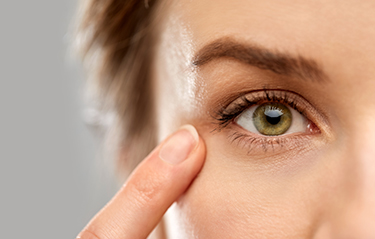The Best Way to Reduce Pterygium Recurrence

If you’ve noticed that you have a clear triangular growth on the surface of your eye, it may be a pterygium. To address this growth, we may recommend surgical pterygium removal. To ensure that the chances of recurrence are very low, we use state-of-the-art AmnioGraft® tissue grafting.
What Is a Pterygium?
To explain what a pterygium is, it’s best to start with some basic eye anatomy. The sclera, or the white of the eye, is protected by clear tissue called the conjunctiva. The iris and the pupil are protected by clear tissue called the cornea.
When the thin conjunctiva tissue grows in a triangular wing or wedge shape that reaches onto the cornea, this is called a pterygium. This eye growth can be large or small and can either form in one eye or both of the eyes.
Factors that can cause the formation of a pterygium include regular exposure to environmental eye irritants like sunlight (especially UV light), dust, sand, and wind. Advanced aging can also result in a pterygium.
While a pterygium is benign, it can still cause a number of issues, including obscured vision, discomfort, swelling, chronic inflammation, and fibrovascular proliferation. It may also feel like there is a foreign object in the eye. Pterygium growths can even result in astigmatism as a result of changes to the cornea’s surface.
What Is Pterygium Eye Surgery with AmnioGraft®?
In certain cases, pterygium growths can reoccur after treatment. To remove a pterygium eye growth and reduce the chance of recurrence, autologous conjunctival autografting eye surgery may be recommended. This outpatient surgery takes 45 minutes or less and is performed under local anesthesia with sedation.
The surgery involves two steps. First, the pterygium is carefully and precisely surgically removed. This leaves the eye’s surface exposed. To restore the protection offered by the conjunctiva, the surgeon must then place AmnioGraft over the eye’s exposed surface.
AmnioGraft is a type of FDA-approved ocular graft material. After a cesarean section birth, mothers donate the amniotic membrane of their placenta for use as AmnioGraft graft material. It is then cryopreserved.
No sutures are necessary after the AmnioGraft material has been positioned. Instead, fibrin glue is used to adhere the graft to the area. Because sutures are not utilized, the recovery is much faster and more comfortable for patients.
Recovery After Pterygium Removal Surgery with AmnioGraft
Once your pterygium growth has been removed with autologous conjunctival autografting eye surgery, an eye patch will be placed over the treated eye. This will help to protect against infection.
Since you’ll still be feeling the effects of sedation, you won’t be able to drive yourself home after the procedure. It’s best to arrange for a friend or family member to give you a ride home.
Your eye doctor will give you post-surgical care directions, which must be followed diligently in order to minimize the chance of complications. They will tell you about the proper way to clean the area and give you information regarding your dosage schedule for anti-inflammatory eyedrops and topical antibiotics.
After around two days of recovery, you’ll be cleared to resume your regular schedule and return to work. A degree of discomfort may be experienced for the first three days. Avoid rubbing your eyes, since this can negatively affect the positioning of the AmnioGraft material.
The fibrin glue used to attach the AmnioGraft material during autologous conjunctival autografting eye surgery will naturally and safely dissolve after around one week. At this point, your eyes will have healed to the point where the glue is no longer necessary.
You will need to come in for a follow-up visit so that your doctor can check on the status of the healing tissues. Full healing time after autologous conjunctival autografting eye surgery typically takes anywhere from two weeks to two months.
Find Out More
The best way to find out more about your pterygium treatment options is by visiting Patel Eye Associates in Edison and Kendall Park, NJ. Contact us to set up your consultation with a skilled and experienced eye doctor.

